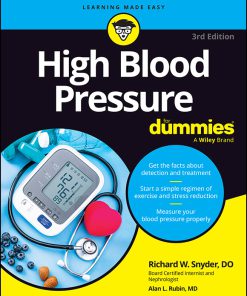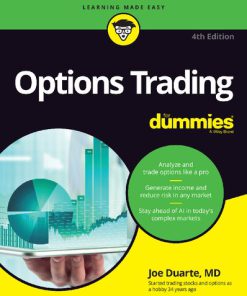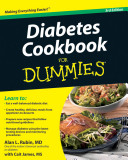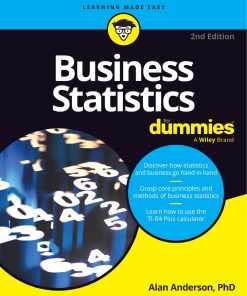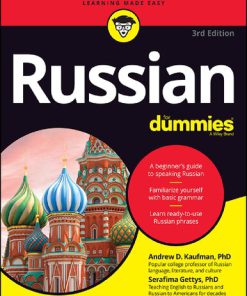ROBERT S RULES FOR DUMMIES 4th Edition by Alan Jennings 9781119824602 1119824605
$50.00 Original price was: $50.00.$25.00Current price is: $25.00.
ROBERT S RULES FOR DUMMIES 4th Edition by Alan Jennings – Ebook PDF Instant Download/Delivery:9781119824602, 1119824605
Full download ROBERT S RULES FOR DUMMIES 4th Edition after payment
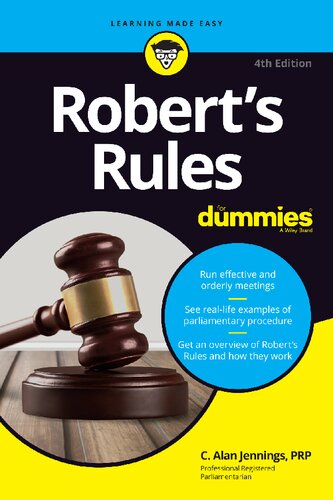
Product details:
ISBN 10: 1119824605
ISBN 13: 9781119824602
Author: C Alan Jennings
All in favor of improving meeting procedures, say Aye!
Trying to keep your in-person and virtual meetings on track and running smoothly? You need Robert’s Rules of Order! These rules for conducting meetings have stood the test of time as the gold standard for practical and effective procedure in group settings like corporate and nonprofit boards, councils, and more. And there’s no better way to learn the latest version of the rules than with Robert’s Rules For Dummies.
This handy guide demystifies the Rules and offers readers a practical roadmap to applying efficient procedures to everything from conducting online and in-person meetings to voting by email. It also:
- Contains brand-new, updated content on the latest 12th Edition of Robert’s Rules
- Offers sample meeting agendas, minutes, scripts, and other material to show you how the pros keep meeting records
- Walks you through the basic–and not so basic–ways to nominate and elect officers and directors in organizations
Ideal for board members, convention delegates, business owners, nonprofit executives, and anyone else trying to maintain an orderly flow of business–online or in person–Robert’s Rules For Dummies is a need-to-read resource that will make you wonder how you ever survived without it.
ROBERT S RULES FOR DUMMIES 4th Table of contents:
Part 1: It’s Parliamentary, My Dear: Participating Effectively in Meetings
Chapter 1: Following the Rules (Robert’s, That Is)
- Keeping Things Informal
- Making Meetings Meaningful
- A Brief History of Robert’s Rules
- Being Empowered at Meetings
- Understanding What Parliamentary Procedure Is
- Achieving Personal Goals
- Experiencing Personal Success
Chapter 2: Defining the Organization: Bylaws and Other Rules
- Covering the Rules about Rules
- Uncovering Bylaw Basics
- Breaking Down the Content of Bylaws
- Making Sure Your Bylaws Are Complete
- Amending Your Bylaws
- Interpreting Bylaws
- Publishing Your Bylaws and Other Rules
Chapter 3: Meetings: Making Group Decisions
- Defining the Deliberative Assembly
- (Un)Tying the Hands of the Assembly in Future Sessions
- Understanding Types of Business Meetings
- Conducting Your Business
- Participating in Meetings as a Member
- Presiding over Meetings with Style
- Relaxing the Rules at Meetings
- Meeting Virtually
Chapter 4: Notice and a Quorum
- Giving Notice of Meetings
- Quorum Defined
Chapter 5: Ordering Business: The Agenda
- Order of Business Sequence
- Using an Agenda
Part 2: Motions: Putting Ideas into Action
Chapter 6: Main Motions: Proposing Ideas for Group Action
- Understanding Motion Basics
- Taking the Plunge with a Main Motion
- Breaking Down the Types of Main Motions
- Giving Previous Notice of Motions
- Working within Limits: Basic Rules for Main Motions
- Avoiding Out-of-Order Main Motions
- Handling a Main Motion in Eight Easy Steps
Chapter 7: Debate: Discussing the Pros and Cons of Ideas
- Understanding the Debate Process
- To Debate or Not to Debate, That is the Question!
- Presiding over the Debate
- Debating As a Member
- Playing Nice: Decorum in Debate
- Dealing with Disruption: Dilatory and Improper Motions
Chapter 8: Making Group Decisions: Voting on the Motion
- Knowing Your Voting Rights and Responsibilities
- Taking Your Pick of Voting Methods
- Allowing Absentee Voting
- Determining Voting Results
Chapter 9: Subsidiary Motions: Helping to Process the Main Motion
- Disposing of a Main Motion
- Ranking the Subsidiary Motions
- Let’s Vote but Say We Didn’t: Postpone Indefinitely
- Making a Change: Amend
- Sending It to Committee: Commit or Refer
- Dealing with It Later: Postpone to a Certain Time (Or Postpone Definitely)
- How Long Can This Go On? Limit or Extend Limits of Debate
- Enough Already! Previous Question
- Doing This Now: Lay on the Table
Chapter 10: Privileged Motions: Getting through the Meeting
- Ranking the Privileged Motions
- Getting Back on Schedule: Call for the Orders of the Day
- It’s Cold in Here: Raise a Question of Privilege
- Taking a Break: Recess
- Time to Get Outta Here: Adjourn
- Finishing on Another Day: Fix the Time to Which to Adjourn
Chapter 11: Incidental Motions: Dealing with Questions of Procedure
- Defining Incidental Motions
- Using Incidental Motions
- Following the Rules: Point of Order
- Sorry, but I Disagree: Appeal
- We Can’t Let That Stop Us: Suspend the Rules
- Oh, Come Now! Objection to the Consideration of a Question
- Too Much in One Fell Swoop: Division of a Question
- Going Over This Carefully: Consideration by Paragraph
- Being Sure about the Vote: Division of the Assembly
- Deciding How to Decide: Motions Related to Methods of Voting and the Polls
- Coming Up with Candidates: Motions Related to Nominations
- I Can’t Take It Anymore! Request to Be Excused from a Duty
- Is It in Order To … ? Parliamentary Inquiry
- Needing to Know More: Request for Information
- Making Other Requests
Chapter 12: Looking At Motions That Bring a Question Again Before the Assembly
- Been There, Done That! Preventing Revoting on Motions
- Having Second Thoughts: Reconsidering
- Rescinding or Amending Something Previously Adopted
- Discharging a Committee
- Examining What’s Left on the Table — Taking from the Table
Part 3: Getting Involved in Leadership
Chapter 13: Who’s Going to Do the Work? Following Nomination Procedures
- Nominations by the Chair
- Nominations from the Floor
- Nominations by a Committee
- Nominations by Ballot
- Nominations by Mail
- Nominations by Petition
Chapter 14: Holding Elections and Making Appointments
- Conducting Elections Like a Maestro
- Filling Vacancies
- Making Committee Appointments
Chapter 15: Running the Show: Officers and Directors
- Perfecting Presidential Presence
- Playing (Not-So) Second Fiddles
- Tackling Other Tasks
- Filling Vacancies in Offices
- Defining Terms of Office
Chapter 16: Gearing Up for the Real Action: Committees
- Defining the Ordinary Committee
- Taking Stock of Committee Appointment Methods
- Appointing Committee Members
- Following Committee Procedures
- Working on a Committee
Chapter 17: Reporting to Your Organization
- Making Minutes Minute
- First Things First: Filing the Treasurer’s Report
- Next Up: Hearing Reports of Other Officers
- Wrapping Up Reporting: Boards and Committees
- Knowing What to Do with Reports and Recommendations
- Recognizing Members’ Rights to Consult the Records
Chapter 18: Disciplining and Removing Officers or Members
- Dealing with a Dictator
- Disciplining Members Who Shame Your Group’s Name
- Maintaining Order in Meetings
Chapter 19: Starting a New Association
- Preparing for an Organizational Meeting
- Inviting Prospective Members
- Holding the First Organizational Meeting
- Drawing Up Your Bylaws
- Holding Your Second Organizational Meeting
- Holding Your Charter Meeting
Chapter 20: The Convention of Delegates: A Special Kind of Assembly
- Defining the Convention of Delegates
- Serving As a Delegate
- Organizing the Convention Assembly
- Understanding Other Convention Committees
Part 4: The Part of Tens
Chapter 21: Ten (Plus Two) Meeting Procedure Myths
- Robert’s Rules Is Just a Guide You Don’t Have to Follow
- Only One Motion Can Be on the Floor at a Time
- The Presiding Officer Can Vote Only to Break a Tie
- The Parliamentarian Makes Rulings
- A Motion Not Seconded Is Void
- Abstentions Count As Yes (or No) Votes
- The Chair Must Ask for Unfinished Business
- The Chair Must Call for Nominations Three Times
- If the Winner Doesn’t Serve, Second Place Can Take Over
- Officers Must Be Members
- Ex Officio Members Can’t Vote
- Motions Don’t Take Effect Until Minutes Are Approved
Chapter 22: Ten Tips for Presiding Officers
- Know Your Rules
- Plan Your Meetings
- Start Your Meetings on Time
- Use Unanimous Consent
- Use Committees
- Preside with Impartiality
- Never Give up the Chair
- Don’t Share Your Lectern
- Keep Your Cool
- Use a Parliamentarian
Chapter 23: Ten Motion Mistakes to Avoid
- “Reconsidering” a Vote
- Speaking without Recognition
- Moving to “Table!”
- Calling the Question
- Tabling It until Next Month
- Offering a Point of Information
- Offering Friendly Amendments
- Making Motions to Accept or Receive Reports
- Dispensing with the Minutes
- Wasting Breath on “I So Move”
Chapter 24: Ten Custom Rules to Consider
- Changing the Ten-Minute Speech Rule
- Defining Your Quorum
- Establishing Rules Related to the Quorum
- Electing by Voice instead of by Ballot
- Adopting Special Vote Thresholds
- Authorizing a Committee to Adopt Its Own Rules
- Authorizing Spending When Adopting Budgets
- Requiring an Adopted Agenda by Rule
- Adopting a Customized Order of Business
- Breaking a Tie in Elections
Chapter 25: Ten Considerations for Electronic Meetings
- Developing Bylaw Provisions
- Making Members Responsible for Connection and Access
- Providing for a Quorum Call
- Obtaining Recognition to Speak
- Interrupting a Speaker
- Establishing Requirements for Motions
- Hearing “What Are We Voting on?” Less Frequently
- Covering Voting Methods
- Noting Comings-and-Goings
- Pulling the Plug
People also search for ROBERT S RULES FOR DUMMIES 4th:
robert’s rules for dummies election of officers
does robert’s rules require agenda
what is robert’s rules
robert’s rules simplified
robert’s rules for dummies pdf
Tags:
Alan Jennings,ROBERT,RULES FOR DUMMIES
You may also like…
Business & Economics - Project Management
Business & Economics
Relationships & Lifestyle - Health - Diseases & Disorders
High Blood Pressure For Dummies Richard Snyder & Alan L. Rubin
Business & Economics - Investing
Relationships & Lifestyle - Diet & Nutrition
Mathematics - Mathematical Statistics
Business Statistics For Dummies 2nd Edition by Alan Anderson ISBN 9781394219926 139421992X
Uncategorized
Russian For Dummies 3rd Edition by Alan Kaufman, Serafima Gettys 1119868602 9781119868613
Business & Economics - Investing
Business & Economics - Job Hunting & Careers





